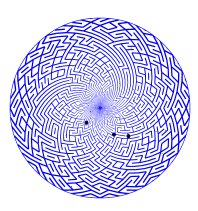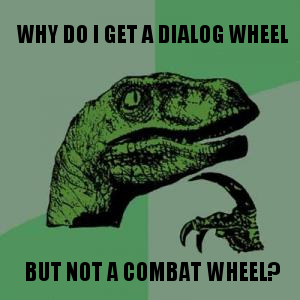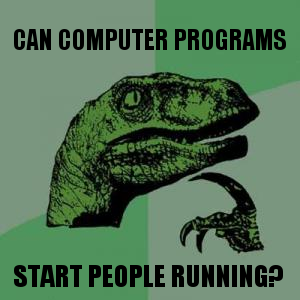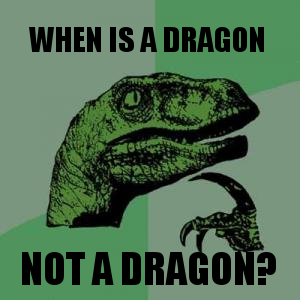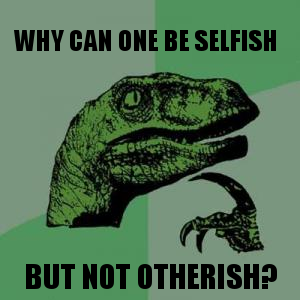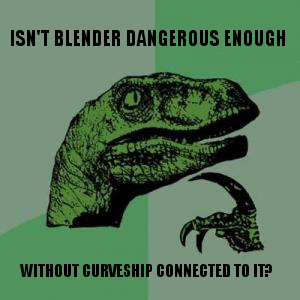The call for submission for the Electronic Literature Collection volume 3 has been posted. If you do digital work that has one or more literary aspects (even if it’s more often called art or a game), in any language, please check it out. The collective is an excellent group and the direction for this collection is an exciting one.
New Report on Nanowatt & World Clock
The latest technical report (or “Trope Report”) to issue from the Trope Tank is TROPE-14-01, “New Novel Machines: Nanowatt and World Clock“ by Nick Montfort:
>My Winchester’s Nightmare: A Novel Machine (1999) was developed to bring the interactor’s input and the system’s output together into a texture like that of novelistic prose. Almost fifteen years later, after an electronic literature practice mainly related to poetry, I have developed two new “novel machines.” Rather than being works of interactive fiction, one (Nanowatt, 2013) is a collaborative demoscene production (specifically, a single-loading VIC-20 demo) and the other (World Clock, 2013) is a novel generator with accompanying printed book. These two productions offer an opportunity to discuss how my own and other highly computational electronic literature relates to the novel. Nanowatt and World Clock are non-interactive but use computation to manipulate language at low levels. I discuss these aspects and other recent electronic literature that engages the novel, considering to what extent novel-like computational literature in general is becoming less interactive and more fine-grained in its involvement with language.
This was the topic of my talk at the recent ELO conference. Share and enjoy!
Do Bots Need to Sit Down?
(My Philosoraptor question for the day…)
Check out Tully Hansen’s riff on one of the poems from bpNichpol’s First Screening – authentic or not …
Stalking the Wily #!
If you’ve been looking for my latest book, #!, and are looking to buy it online, check isbn.nu. At the moment of posting, it’s available from three sellers, one on pre-order. Barnes & Noble is the bookseller with the lowest price and fastest delivery; Amazon.com offers to get it to you 3-4 weeks later.
In Cambridge, I have yet to see the book on shelves, but I know copies are at least on order (if not readied for purchase) at the MIT Press Bookstore and the Harvard Bookstore. And, Grolier Poetry Book Shop also had a few copies.
Update, July 17, 5pm: The local place to get a copy of #!, at the moment, is the MIT Press Bookstore. That’s at 292 Main Street, right outside the Kendall T stop. This is the MIT Press Bookstore, not the MIT Coop, and in the “Faculty Authors” section they do currently stock copies of my latest book.
Update, July 18, 1pm: B&N no longer has the book listed for whatever reason. It can be obtained online, right now, from Small Press Distribution, though.
10 PRINT in Clock 52
Clocks are great machines to design, at least from my perspective as a designer of software machines. My classes have had unusual clock design as an exercise; time-telling systems are not interactive, provide a lot of freedom to the designer, and yet require programmers to develop general functions that work for any time of the day. I know that Michael Mateas and Paolo Pedercini have students program clocks, too. I’ve appreciated software clocks by John Maeda and others, and it’s nice to have a clock as a standard example in Processing.
So, I was delighted to see that 10 PRINT CHR$(205.5+RND(1)); : GOTO 10 inspired Vincent Toups to create a another of his many aesthetic software clocks, Clock 52.
The Times Has a Moment with IF
The New York Times has an article (online today, in print tomorrow) entitled “Text Games in a New Era of Stories,” about ye olde interactive fiction and new-fangled manifestations of it, including Ms. Porpentine’s Howling Dogs and Ms. Short’s Blood & Laurels.
(Okay, it must be admitted that even The New York Times didn’t refer to the author of Howling Dogs as “Ms. Porpentine.”)
Techsty #9, with Sea and Spar Between in Polish
 Exciting news for Polish-readers (and, I think, others): The new issue of Techsty, number 9, is out. You might think that a “Techsty” is just a place where infopigs like me live, but it’s actually a long-running site (since 2001) on digital literature, with an esteemed journal that has been published since 2003.
Exciting news for Polish-readers (and, I think, others): The new issue of Techsty, number 9, is out. You might think that a “Techsty” is just a place where infopigs like me live, but it’s actually a long-running site (since 2001) on digital literature, with an esteemed journal that has been published since 2003.
The current issue includes translations of articles by Robert Coover and Brain McHale, an article by Seweryna Wysłouch, and a special section on an audacious project. This is the translation of Sea and Spar Between, by Nick Montfort and Stephanie Strickland, which is a fairly extensive special-purpose poetry generator that is fair entwined with the English language (as well the specific authors from whom it draws: Emily Dickinson and Herman Melville). Not only did the two translators tackle the difficult and in fact unprecedented task of translating the underlying system to Polish, so that the program generates stanzas in that language; they also translated our comments from the “cut to fit the toolspun course” edition of the work. I hope this will invite remixing and code re-use in Polish as well as helping to improve the understanding of our project and our collaboration. Monika Górska-Olesińska also has an article on Stephanie Strickland’s work, with a photo of Stephanie reading just a few days ago at the ELO conference.
Piotr Marecki also translated my short generator Lede for the issue. (Amusingly enough, the translated title is the more conventional and seemingly more properly-spelled English word “Lead.”) It has some aspects of cultural translation – absurd figures from Polish culture are substituted for some of the ones I included from my American perspective.
The only mistake I see in the Sea and Spar Between items is that it’s hard (for me, at least, not being a reader of the language) to determine who did the translation of both the poem generator and the comments: Monika Górska-Olesińska and Mariusz Pisarski, who are attributed atop the commented code but not, for instance, here on the Polish “How to Read” page. In digital literature, there generally is no system for buying rights and recruiting and paying translators for their work – just as there is no system for doing this for authors. So the least we can do is to properly credit those who work to develop new programs and cybertexts, whether they are based on earlier ones in other languages or not.
The final article I’ll note is an interview, I think one that’s very kind to me and my lab, The Trope Tank, by Piotr Marecki, who was a postdoc here this past year. Here’s what the Googly Intelligence translates this interview as.
There’s a great deal more in the issue, and I suggest those interested in digital literature, even if not literate in Polish, take at least a quick look using your favorite “translation goggles.” There are some good English-language journals on electronic literature, but I think English-speakers could learn a good deal from this effort, which publishes critical writing (including some in translation) and creative work and also undertakes extensive translation projects.
“Left Cartridge,” a Zine
Everything you need to know to print out and bind a copy of Left Cartridge, a zine documenting the Learning Games Initiative, is online.
Digital Media Studies via GIF
Crazy idea? Of course. And yet Zach Whalen has been doing it, quite successfully, on Tumblr. For instance, here’s his brand-aware version of Brion Gysin’s permutation poem:

And his speedrun of Lexia to Perplexia:

Not to mention the excellent staticy CRTs, captured from films and TV, not to mention the exquisite and worth-the-trip Zen for GIF.
Computational Narrative and Games (Special Issue)
A special issue of IEEE Transactions on Computational Intelligence and AI in Games (TCIAIG) is now out — I mention it because I was one of the editors, and the issue deals with computational narrative and games.
Here’s the link to the computational narrative and games issue. It was edited by Ian Horswill, Nick Montfort and Michael Young. And here’s what is in it:
Guest Editorial
Horswill, I.D; Montfort, N; Young, R.M
p 92-96
Social Story Worlds With Comme il Faut
McCoy, J. ; Treanor, M. ; Samuel, B. ; Reed, A.A. ; Mateas, M. ; Wardrip-Fruin, N.
p 97-112
Versu—A Simulationist Storytelling System
Evans, R. ; Short, E.
p 113-130
A Computational Model of Narrative Generation for Surprise Arousal
Bae, B.-C. ; Young, R.M.
p 131-143
Automated Story Selection for Color Commentary in Sports
Lee, G. ; Bulitko, V. ; Ludvig, E.A.
p 144-155
Skald: Minstrel Reconstructed
Tearse, B. ; Mawhorter, P. ; Mateas, M. ; Wardrip-Fruin, N.
p 156-165
Designing User-Character Dialog in Interactive Narratives: An Exploratory Experiment
Endrass, B. ; Klimmt, C. ; Mehlmann, G. ; Andre, E. ; Roth, C.
p 166-173
Personalized Interactive Narratives via Sequential Recommendation of Plot Points
Yu, H. ; Riedl, M.O.
p 174-187
Lessons on Using Computationally Generated Influence for Shaping Narrative Experiences
Roberts, D.L. ; Isbell, C.L.
p 188-202
A Supervised Learning Framework for Modeling Director Agent Strategies in Educational Interactive Narrative
Lee, S.Y. ; Rowe, J.P. ; Mott, B.W. ; Lester, J.C.
p 203-214
Shall I Compare Thee to Another Story?—An Empirical Study of Analogy-Based Story Generation
Zhu, J. ; Ontanon, S.
p 216-227
Analysis of ReGEN as a Graph-Rewriting System for Quest Generation
Kybartas, B. ; Verbrugge, C.
p 228 – 241
Thoughts from INT7, Day One
(These pertain to Intelligent Narrative Technologies 7, and specifically today’s presentations. Perhaps, if you’re here, you will laugh. If you aren’t here, my regrets.)
Waves 3 Ways at @Party
codewiz and I (nom de nom) showed a wild demo at @party yesterday (June 14) at MIT.
It was “Waves 3 Ways (Topsy’s Revenge).” Indeed, there’s video.
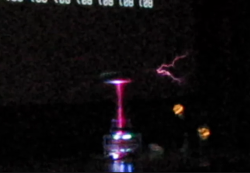 The concept is based on one-line C programs to generate music, the earliest of which were by viznut. I (nom de nom) wrote a C expression in this style to generate a waveform that could be output as sound but
The concept is based on one-line C programs to generate music, the earliest of which were by viznut. I (nom de nom) wrote a C expression in this style to generate a waveform that could be output as sound but
also consisted of all printable ASCII characters. The source is about 1kb, without much effort at compression. And the sound, in addition to driving speakers, can be (and was) connected to a Tesla coil.
To connect the oneTesla coil he built, codewiz modified the firmware and the control box to allow the audio output to be read by the potentiometer input. He also wrote dsptee.c to improve the way the text scrolls.
Topsy was the elephant electrocuted by Thomas Edison in 1903 to help prove that AC electricity (advocated by Tesla) was unsafe.
My main disappointment was that the projector, which I thought would be HD and thus the same as my display, showed only the left-hand side of the video. I should have checked it more thoroughly before we got started.
We were very pleased to get second place behind a nice oscilloscope demo.
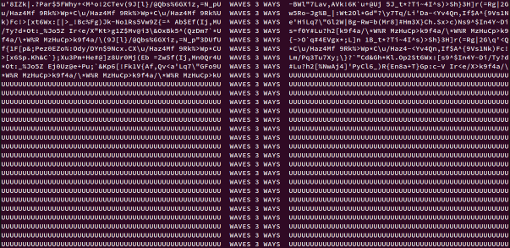
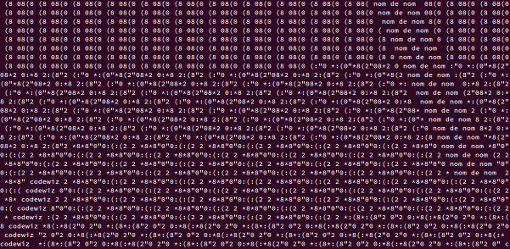
The final section of the demo is based on the bpNichol poem “Island,” part of his Apple IIe collection First Screening. This poem, in turn, refers to a concrete poem by Ian Hamilton Finlay. I’ve put a video/screencast of the end of the production online.
There’s a party — Perverbs.
I persist in my quest to develop extremely simple, easily modifiable programs that produce compelling textual output.
My latest project is Modern Perverbs. In a world where nothing is as it seems … two phrases … combine … to make a perverb. That’s about all there is to it. If phrase N is picked from the first list, some phrase that isn’t number N will be picked from the second, to ensure maximum perverbiality. The first phrase also carries the punctuation mark that will be used at the very end. This one is a good bit simpler than even my very simple “exploded sentence” project, Lede.
(I learned of perverbs and their power, I should note, thanks to Selected Declarations of Dependence by Harry Mathews.)
In case, for some reason, you fear the legal repercussions of ripping off my HTML and JavaScript and editing it, Modern Perverbs is explicitly licensed as free software. Save the page on your desktop as plain HTML (not “complete”), open it in an editor, and have a field day.
Sounds, User-Input Phrases, and Monkeys in “Taroko Gorge”
Check out “Wandering through Taroko Gorge,” a participatory, audio-enabled remix.
As James T. Burling stated on the “projects” page of MAD THEORY:
>In this combination of presentation and poetry reading, I’ll present a remix of Nick Monfort’s javascript poetry generator, “Taroko Gorge.” My remix added a musical component using a computers oscilloscope function, and more importantly allows participant-observers to type in answers to prompts which are then added to the poem in real-time. The poem will be available throughout the day, gradually adding all inputs to its total sum. I’ll discuss the process of decoding html and javascript as a non-coder, describe some of my theories on participatory performance using computer interfaces, and raise questions about agency in performance and how a digital artifact can function as a poetic event.
Jill Walker Rettberg, this Monday’s Purple Blurb
MIT, room 14E-310
Monday 5/5, 5:30pm
Free and open to the public, no reservation required
Jill Walker Rettberg
“Seeing Ourselves Through Technology: How We Use Selfies, Blogs and Wearable Devices to Understand Ourselves”
 This Monday (2014-05-05) the Purple Blurb series of Spring 2014 presentations will conclude with a talk by Jill Walker Rettberg on a pervasive but still not well-understood phenomenon, the types of digital writing, tracking, photography, and media production of other sorts that people do about themselves. Her examples will be drawn from her own work as well as from photobooths, older self-portraits, and entries from others’ diaries.
This Monday (2014-05-05) the Purple Blurb series of Spring 2014 presentations will conclude with a talk by Jill Walker Rettberg on a pervasive but still not well-understood phenomenon, the types of digital writing, tracking, photography, and media production of other sorts that people do about themselves. Her examples will be drawn from her own work as well as from photobooths, older self-portraits, and entries from others’ diaries.
Jill Walker Rettberg is Professor of Digital Culture at the University of Bergen in Norway. Her research centers on how we tell stories online, and she has published on electronic literature, digital art, blogging, games and selfies. She has written a research blog, jilltxt.net, since October 2000, and co-wrote the first academic paper on blogs in 2002. Her book _Blogging_ was published in a second edition in 2014. In 2008 she co-edited an anthology of scholarly articles on _World of Warcraft._ Jill is currently writing a book on technologically mediated self-representations, from blogs and selfies to automated diaries and visualisations of data from wearable devices.
More about Purple Blurb …
Slice of Trope
Slice of MIT, an MIT alumni publication, has an article on my work with poetry and computation. It’s by Kate Hoagland, was written for National Poetry Month, and is an excellent short discussion of several recent projects and some themes in my work and that of my lab, The Trope Tank.
Scott Rettberg in Purple Blurb this Monday
MIT, room 14E-310
Monday 4/28, 5:30pm
Free and open to the public, no reservation required
Scott Rettberg
 This Monday (2014-04-28) Purple Blurb is proud to host a screening and discussion of narrative video art work done in collaboration with Roderick Coover, including _The Last Volcano, Cats and Rats, Three Rails Live,_ and _Toxicity._ (The last two are combinatory pieces; _Three Rails Live_ is a collaboration between Coover, Rettberg, and Nick Montfort.) These pieces deal with personal and global catastrophes and are written across languages, with one of the voices in _Cats and Rats_ in (subtitled) Norwegian. They continue Rettberg’s work on novel-length electronic literature projects and his frequent collaboration with others.
This Monday (2014-04-28) Purple Blurb is proud to host a screening and discussion of narrative video art work done in collaboration with Roderick Coover, including _The Last Volcano, Cats and Rats, Three Rails Live,_ and _Toxicity._ (The last two are combinatory pieces; _Three Rails Live_ is a collaboration between Coover, Rettberg, and Nick Montfort.) These pieces deal with personal and global catastrophes and are written across languages, with one of the voices in _Cats and Rats_ in (subtitled) Norwegian. They continue Rettberg’s work on novel-length electronic literature projects and his frequent collaboration with others.
Scott Rettberg is Professor of Digital Culture in the department of Linguistic, Literary, and Aesthetic studies at the University of Bergen, Norway. Rettberg is the project leader of ELMCIP (Electronic Literature as a Model of Creativity and Innovation in Practice), a HERA-funded collaborative research project, and a founder of the Electronic Literature Organization. Rettberg is the author or coauthor of novel-length works of electronic literature, combinatory poetry, and films including _The Unknown, Kind of Blue, Implementation, Frequency, Three Rails Live,_ and _Toxicity._ His creative work has been exhibited online and at art venues including the Chemical Heritage Foundation Museum, Palazzo dell Arti Napoli, Beall Center, the Slought Foundation, and The Krannert Art Museum.
More about Purple Blurb …


